A Detailed Analysis: Jamuna Multi-purpose Bridge Project in Bangladesh
VerifiedAdded on 2019/12/03
|10
|3176
|163
Report
AI Summary
This report provides a comprehensive analysis of the Jamuna Multi-purpose Bridge Project (JMPB) in Bangladesh. The project, completed in 1998, aimed to connect the eastern and western halves of the country separated by the Jamuna River, facilitating transportation and economic growth. The report examines the project's scope, including the construction of the bridge, approach roads, river control work, and management services. It discusses the project's cost, funding sources, and implementation challenges, such as delays in contractor selection and land acquisition issues. The report also explores the project's economic and social impacts, including reduced travel times, increased agricultural productivity, and improved access to utilities. Furthermore, it analyzes the factors that contributed to the project's success, such as political commitment, environmental protection measures, and effective project management. The analysis draws on various case studies and research papers to present a detailed overview of the JMPB project.
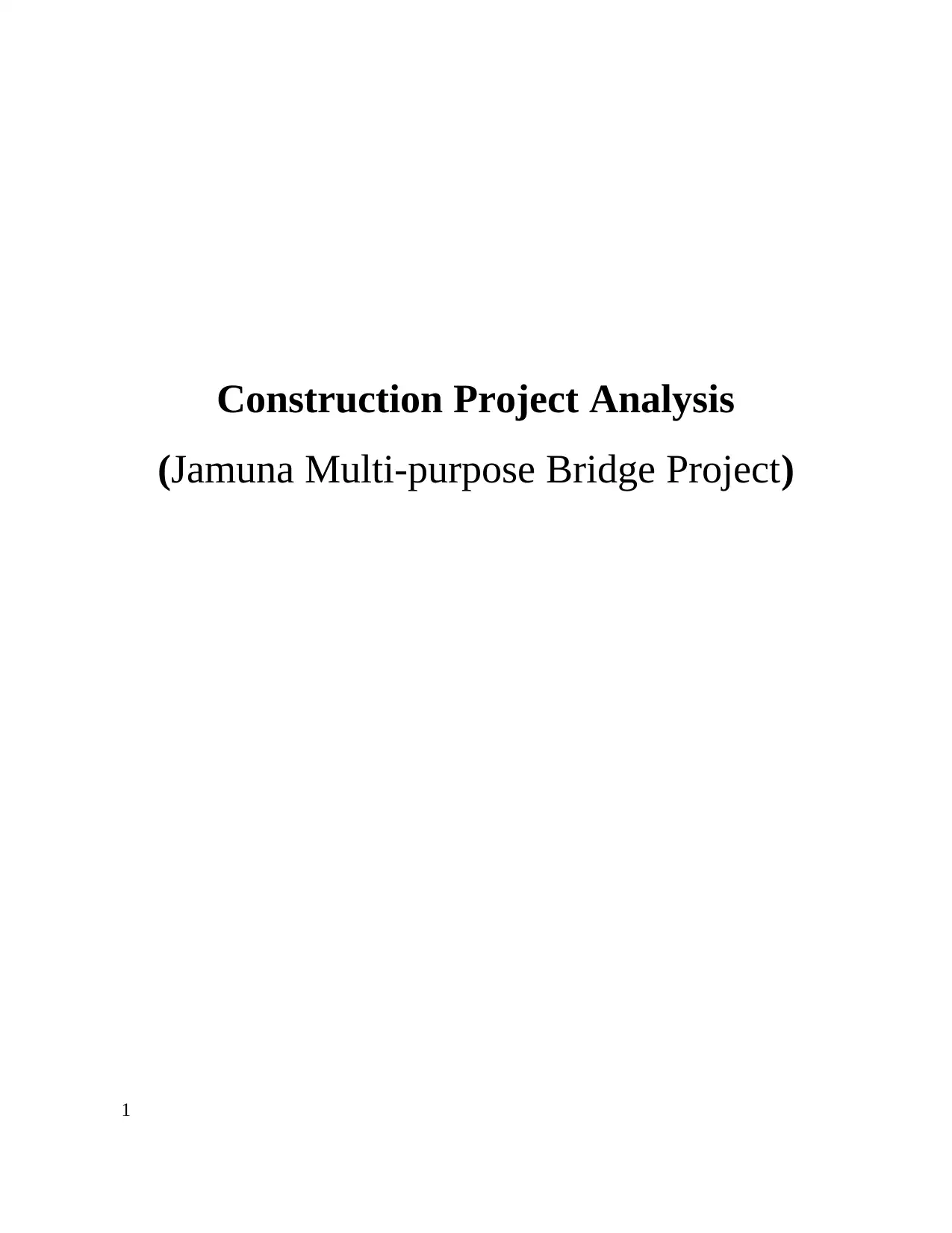
Construction Project Analysis
(Jamuna Multi-purpose Bridge Project)
1
(Jamuna Multi-purpose Bridge Project)
1
Paraphrase This Document
Need a fresh take? Get an instant paraphrase of this document with our AI Paraphraser
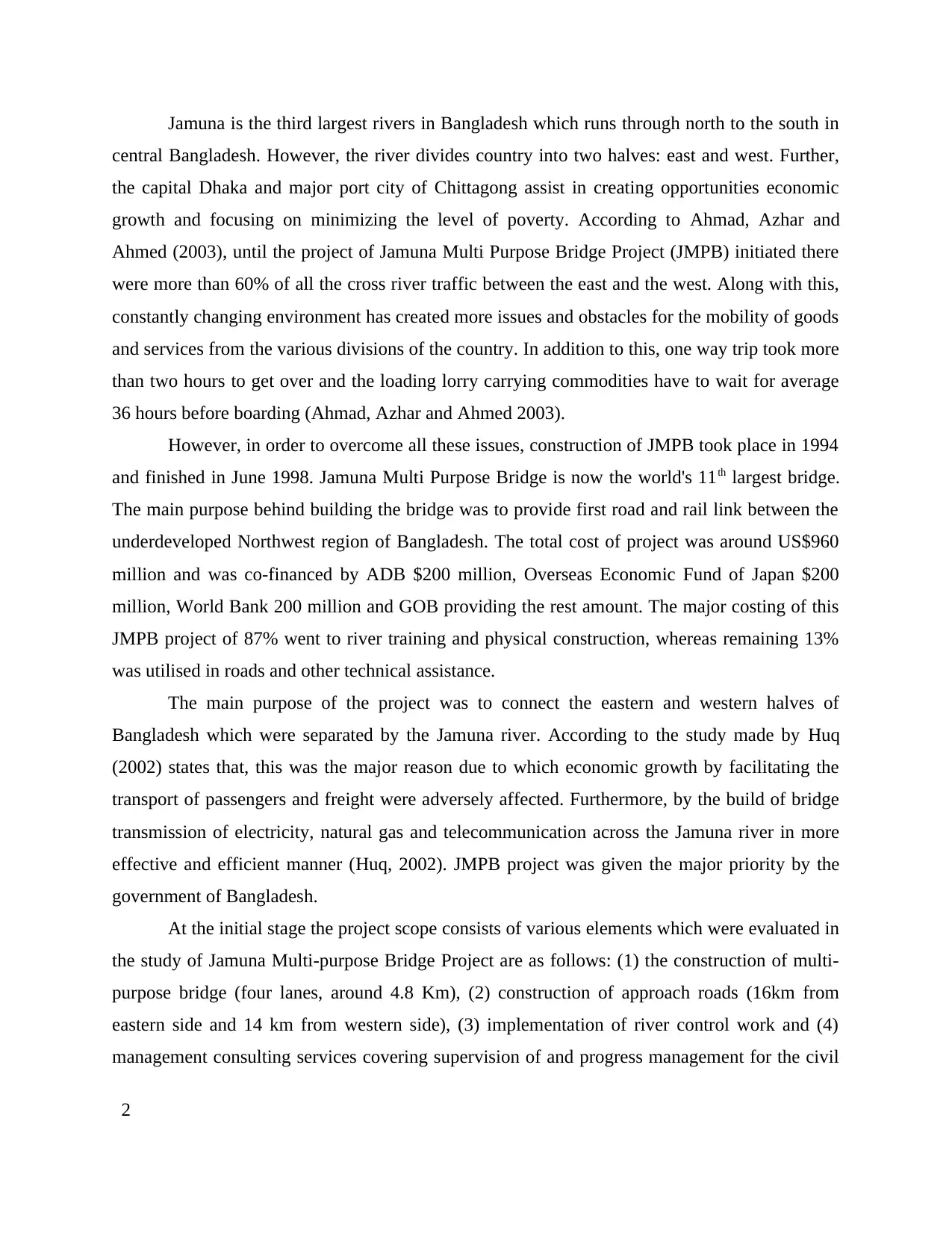
Jamuna is the third largest rivers in Bangladesh which runs through north to the south in
central Bangladesh. However, the river divides country into two halves: east and west. Further,
the capital Dhaka and major port city of Chittagong assist in creating opportunities economic
growth and focusing on minimizing the level of poverty. According to Ahmad, Azhar and
Ahmed (2003), until the project of Jamuna Multi Purpose Bridge Project (JMPB) initiated there
were more than 60% of all the cross river traffic between the east and the west. Along with this,
constantly changing environment has created more issues and obstacles for the mobility of goods
and services from the various divisions of the country. In addition to this, one way trip took more
than two hours to get over and the loading lorry carrying commodities have to wait for average
36 hours before boarding (Ahmad, Azhar and Ahmed 2003).
However, in order to overcome all these issues, construction of JMPB took place in 1994
and finished in June 1998. Jamuna Multi Purpose Bridge is now the world's 11th largest bridge.
The main purpose behind building the bridge was to provide first road and rail link between the
underdeveloped Northwest region of Bangladesh. The total cost of project was around US$960
million and was co-financed by ADB $200 million, Overseas Economic Fund of Japan $200
million, World Bank 200 million and GOB providing the rest amount. The major costing of this
JMPB project of 87% went to river training and physical construction, whereas remaining 13%
was utilised in roads and other technical assistance.
The main purpose of the project was to connect the eastern and western halves of
Bangladesh which were separated by the Jamuna river. According to the study made by Huq
(2002) states that, this was the major reason due to which economic growth by facilitating the
transport of passengers and freight were adversely affected. Furthermore, by the build of bridge
transmission of electricity, natural gas and telecommunication across the Jamuna river in more
effective and efficient manner (Huq, 2002). JMPB project was given the major priority by the
government of Bangladesh.
At the initial stage the project scope consists of various elements which were evaluated in
the study of Jamuna Multi-purpose Bridge Project are as follows: (1) the construction of multi-
purpose bridge (four lanes, around 4.8 Km), (2) construction of approach roads (16km from
eastern side and 14 km from western side), (3) implementation of river control work and (4)
management consulting services covering supervision of and progress management for the civil
2
central Bangladesh. However, the river divides country into two halves: east and west. Further,
the capital Dhaka and major port city of Chittagong assist in creating opportunities economic
growth and focusing on minimizing the level of poverty. According to Ahmad, Azhar and
Ahmed (2003), until the project of Jamuna Multi Purpose Bridge Project (JMPB) initiated there
were more than 60% of all the cross river traffic between the east and the west. Along with this,
constantly changing environment has created more issues and obstacles for the mobility of goods
and services from the various divisions of the country. In addition to this, one way trip took more
than two hours to get over and the loading lorry carrying commodities have to wait for average
36 hours before boarding (Ahmad, Azhar and Ahmed 2003).
However, in order to overcome all these issues, construction of JMPB took place in 1994
and finished in June 1998. Jamuna Multi Purpose Bridge is now the world's 11th largest bridge.
The main purpose behind building the bridge was to provide first road and rail link between the
underdeveloped Northwest region of Bangladesh. The total cost of project was around US$960
million and was co-financed by ADB $200 million, Overseas Economic Fund of Japan $200
million, World Bank 200 million and GOB providing the rest amount. The major costing of this
JMPB project of 87% went to river training and physical construction, whereas remaining 13%
was utilised in roads and other technical assistance.
The main purpose of the project was to connect the eastern and western halves of
Bangladesh which were separated by the Jamuna river. According to the study made by Huq
(2002) states that, this was the major reason due to which economic growth by facilitating the
transport of passengers and freight were adversely affected. Furthermore, by the build of bridge
transmission of electricity, natural gas and telecommunication across the Jamuna river in more
effective and efficient manner (Huq, 2002). JMPB project was given the major priority by the
government of Bangladesh.
At the initial stage the project scope consists of various elements which were evaluated in
the study of Jamuna Multi-purpose Bridge Project are as follows: (1) the construction of multi-
purpose bridge (four lanes, around 4.8 Km), (2) construction of approach roads (16km from
eastern side and 14 km from western side), (3) implementation of river control work and (4)
management consulting services covering supervision of and progress management for the civil
2
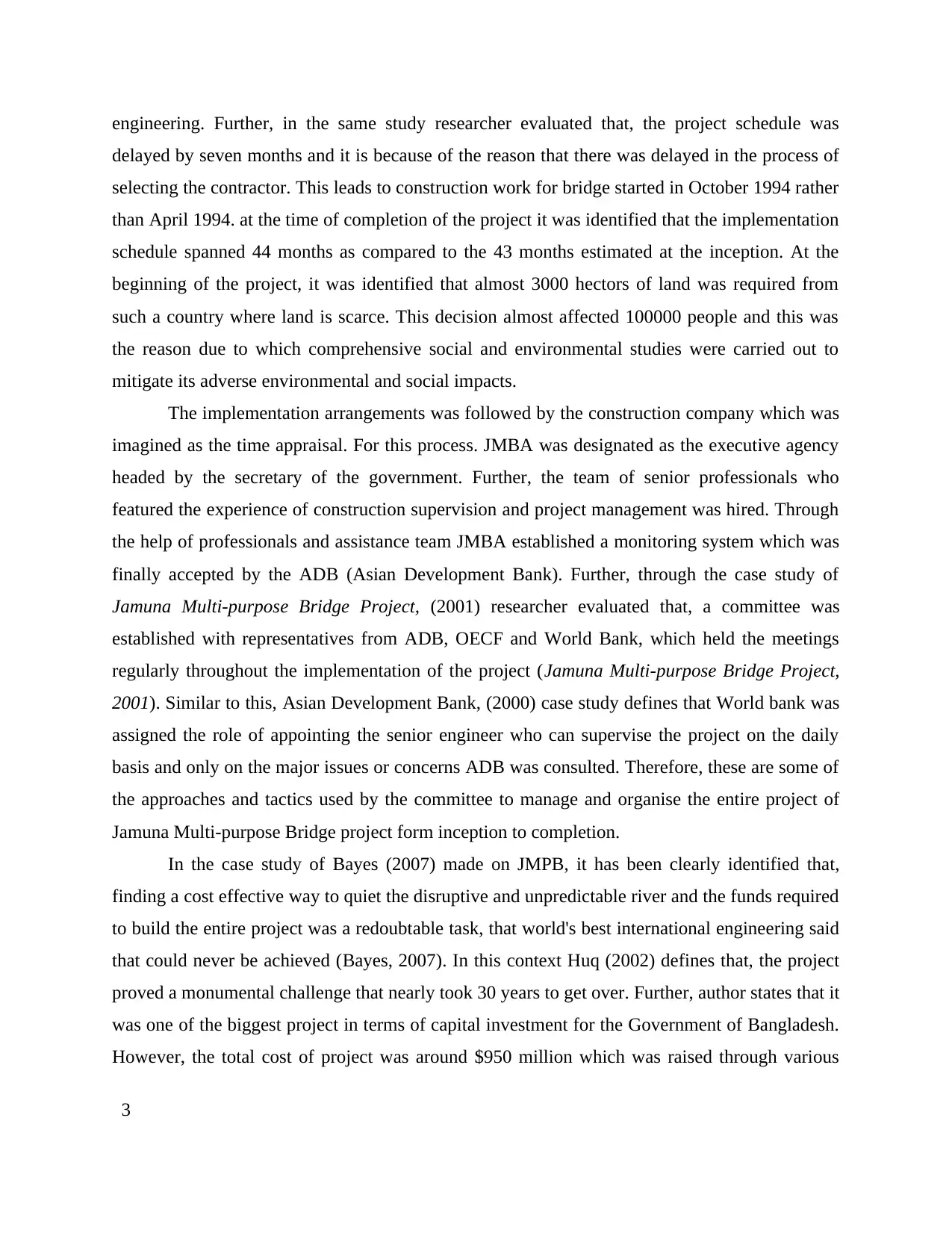
engineering. Further, in the same study researcher evaluated that, the project schedule was
delayed by seven months and it is because of the reason that there was delayed in the process of
selecting the contractor. This leads to construction work for bridge started in October 1994 rather
than April 1994. at the time of completion of the project it was identified that the implementation
schedule spanned 44 months as compared to the 43 months estimated at the inception. At the
beginning of the project, it was identified that almost 3000 hectors of land was required from
such a country where land is scarce. This decision almost affected 100000 people and this was
the reason due to which comprehensive social and environmental studies were carried out to
mitigate its adverse environmental and social impacts.
The implementation arrangements was followed by the construction company which was
imagined as the time appraisal. For this process. JMBA was designated as the executive agency
headed by the secretary of the government. Further, the team of senior professionals who
featured the experience of construction supervision and project management was hired. Through
the help of professionals and assistance team JMBA established a monitoring system which was
finally accepted by the ADB (Asian Development Bank). Further, through the case study of
Jamuna Multi-purpose Bridge Project, (2001) researcher evaluated that, a committee was
established with representatives from ADB, OECF and World Bank, which held the meetings
regularly throughout the implementation of the project (Jamuna Multi-purpose Bridge Project,
2001). Similar to this, Asian Development Bank, (2000) case study defines that World bank was
assigned the role of appointing the senior engineer who can supervise the project on the daily
basis and only on the major issues or concerns ADB was consulted. Therefore, these are some of
the approaches and tactics used by the committee to manage and organise the entire project of
Jamuna Multi-purpose Bridge project form inception to completion.
In the case study of Bayes (2007) made on JMPB, it has been clearly identified that,
finding a cost effective way to quiet the disruptive and unpredictable river and the funds required
to build the entire project was a redoubtable task, that world's best international engineering said
that could never be achieved (Bayes, 2007). In this context Huq (2002) defines that, the project
proved a monumental challenge that nearly took 30 years to get over. Further, author states that it
was one of the biggest project in terms of capital investment for the Government of Bangladesh.
However, the total cost of project was around $950 million which was raised through various
3
delayed by seven months and it is because of the reason that there was delayed in the process of
selecting the contractor. This leads to construction work for bridge started in October 1994 rather
than April 1994. at the time of completion of the project it was identified that the implementation
schedule spanned 44 months as compared to the 43 months estimated at the inception. At the
beginning of the project, it was identified that almost 3000 hectors of land was required from
such a country where land is scarce. This decision almost affected 100000 people and this was
the reason due to which comprehensive social and environmental studies were carried out to
mitigate its adverse environmental and social impacts.
The implementation arrangements was followed by the construction company which was
imagined as the time appraisal. For this process. JMBA was designated as the executive agency
headed by the secretary of the government. Further, the team of senior professionals who
featured the experience of construction supervision and project management was hired. Through
the help of professionals and assistance team JMBA established a monitoring system which was
finally accepted by the ADB (Asian Development Bank). Further, through the case study of
Jamuna Multi-purpose Bridge Project, (2001) researcher evaluated that, a committee was
established with representatives from ADB, OECF and World Bank, which held the meetings
regularly throughout the implementation of the project (Jamuna Multi-purpose Bridge Project,
2001). Similar to this, Asian Development Bank, (2000) case study defines that World bank was
assigned the role of appointing the senior engineer who can supervise the project on the daily
basis and only on the major issues or concerns ADB was consulted. Therefore, these are some of
the approaches and tactics used by the committee to manage and organise the entire project of
Jamuna Multi-purpose Bridge project form inception to completion.
In the case study of Bayes (2007) made on JMPB, it has been clearly identified that,
finding a cost effective way to quiet the disruptive and unpredictable river and the funds required
to build the entire project was a redoubtable task, that world's best international engineering said
that could never be achieved (Bayes, 2007). In this context Huq (2002) defines that, the project
proved a monumental challenge that nearly took 30 years to get over. Further, author states that it
was one of the biggest project in terms of capital investment for the Government of Bangladesh.
However, the total cost of project was around $950 million which was raised through various
3
⊘ This is a preview!⊘
Do you want full access?
Subscribe today to unlock all pages.

Trusted by 1+ million students worldwide
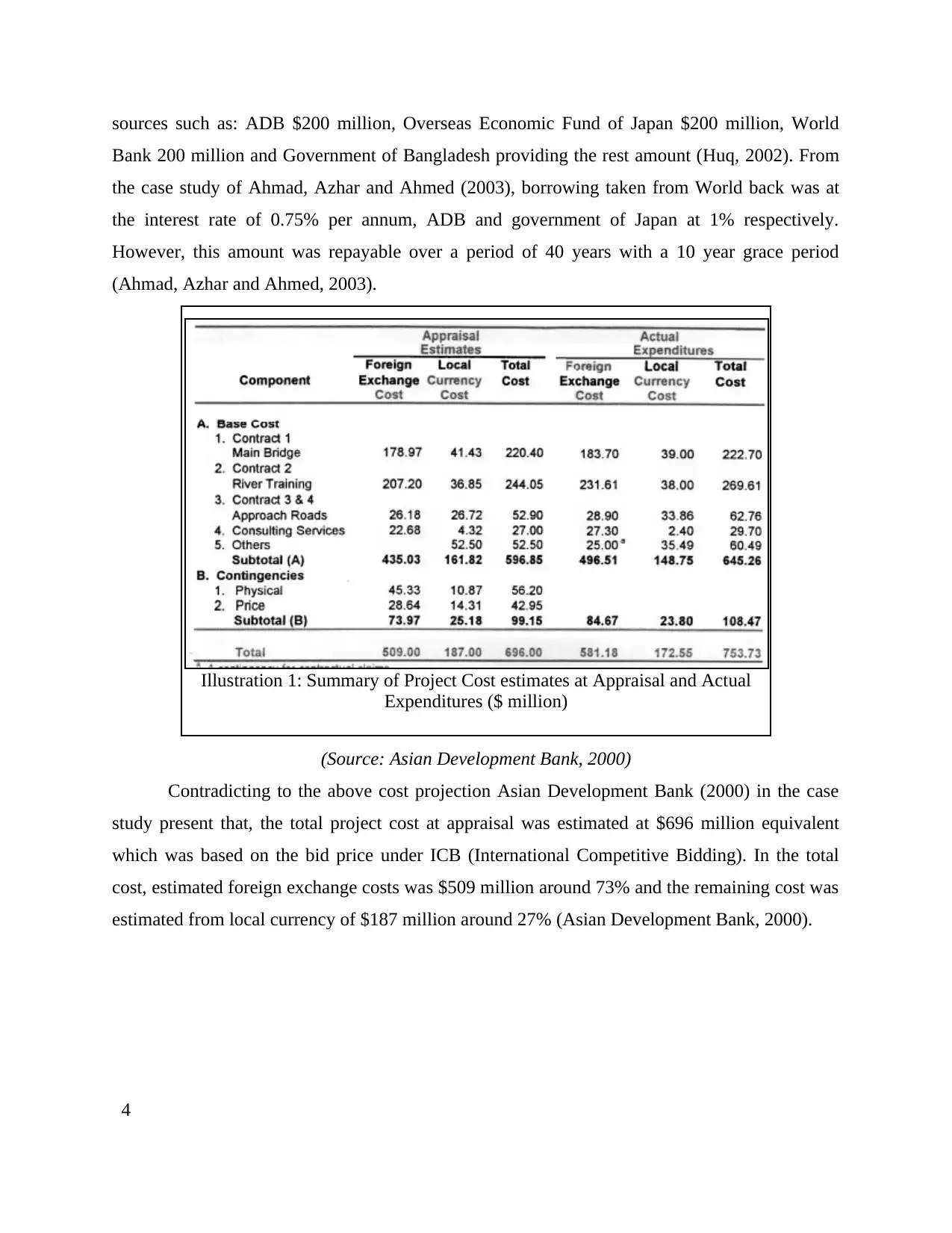
sources such as: ADB $200 million, Overseas Economic Fund of Japan $200 million, World
Bank 200 million and Government of Bangladesh providing the rest amount (Huq, 2002). From
the case study of Ahmad, Azhar and Ahmed (2003), borrowing taken from World back was at
the interest rate of 0.75% per annum, ADB and government of Japan at 1% respectively.
However, this amount was repayable over a period of 40 years with a 10 year grace period
(Ahmad, Azhar and Ahmed, 2003).
(Source: Asian Development Bank, 2000)
Contradicting to the above cost projection Asian Development Bank (2000) in the case
study present that, the total project cost at appraisal was estimated at $696 million equivalent
which was based on the bid price under ICB (International Competitive Bidding). In the total
cost, estimated foreign exchange costs was $509 million around 73% and the remaining cost was
estimated from local currency of $187 million around 27% (Asian Development Bank, 2000).
4
Illustration 1: Summary of Project Cost estimates at Appraisal and Actual
Expenditures ($ million)
Bank 200 million and Government of Bangladesh providing the rest amount (Huq, 2002). From
the case study of Ahmad, Azhar and Ahmed (2003), borrowing taken from World back was at
the interest rate of 0.75% per annum, ADB and government of Japan at 1% respectively.
However, this amount was repayable over a period of 40 years with a 10 year grace period
(Ahmad, Azhar and Ahmed, 2003).
(Source: Asian Development Bank, 2000)
Contradicting to the above cost projection Asian Development Bank (2000) in the case
study present that, the total project cost at appraisal was estimated at $696 million equivalent
which was based on the bid price under ICB (International Competitive Bidding). In the total
cost, estimated foreign exchange costs was $509 million around 73% and the remaining cost was
estimated from local currency of $187 million around 27% (Asian Development Bank, 2000).
4
Illustration 1: Summary of Project Cost estimates at Appraisal and Actual
Expenditures ($ million)
Paraphrase This Document
Need a fresh take? Get an instant paraphrase of this document with our AI Paraphraser
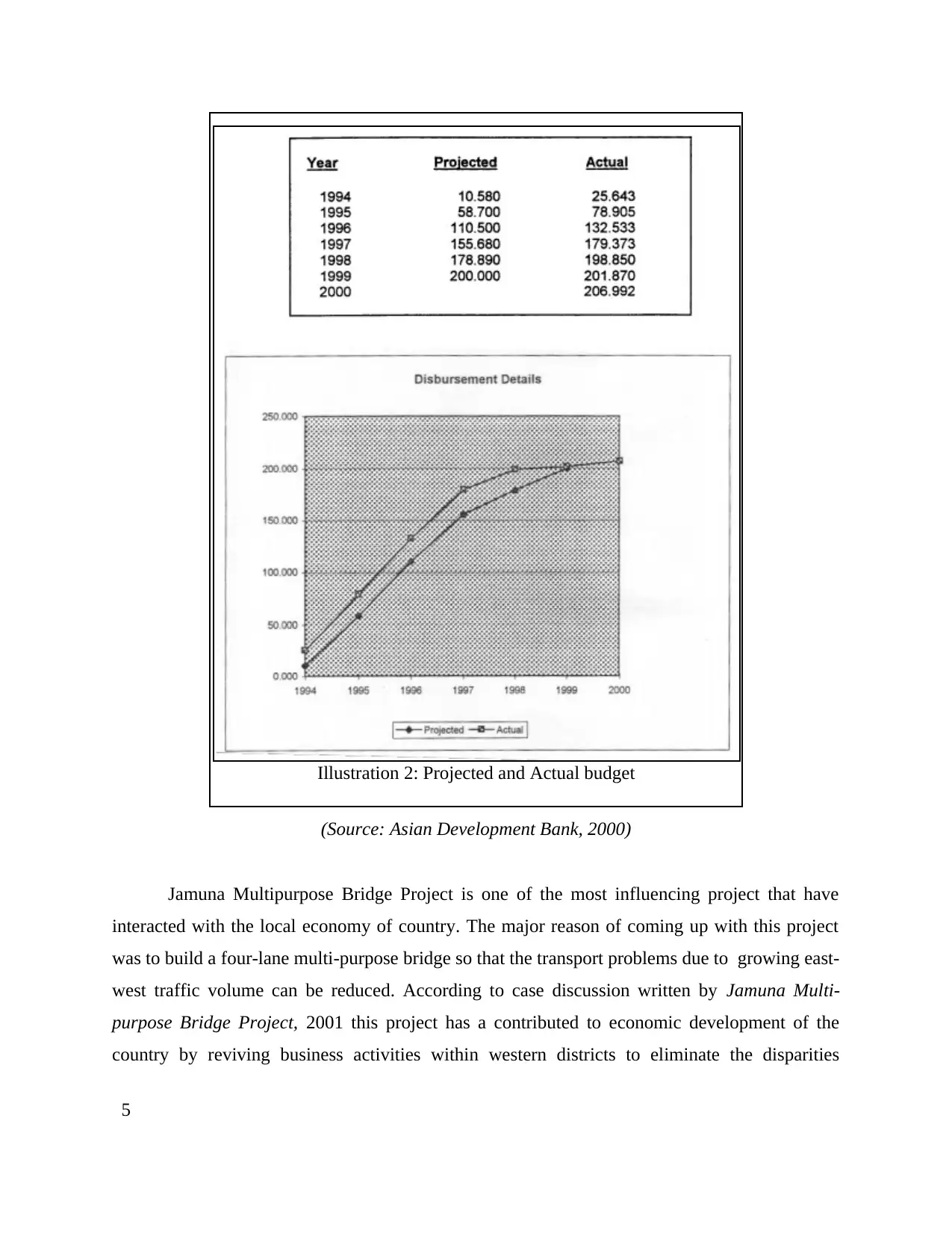
(Source: Asian Development Bank, 2000)
Jamuna Multipurpose Bridge Project is one of the most influencing project that have
interacted with the local economy of country. The major reason of coming up with this project
was to build a four-lane multi-purpose bridge so that the transport problems due to growing east-
west traffic volume can be reduced. According to case discussion written by Jamuna Multi-
purpose Bridge Project, 2001 this project has a contributed to economic development of the
country by reviving business activities within western districts to eliminate the disparities
5
Illustration 2: Projected and Actual budget
Jamuna Multipurpose Bridge Project is one of the most influencing project that have
interacted with the local economy of country. The major reason of coming up with this project
was to build a four-lane multi-purpose bridge so that the transport problems due to growing east-
west traffic volume can be reduced. According to case discussion written by Jamuna Multi-
purpose Bridge Project, 2001 this project has a contributed to economic development of the
country by reviving business activities within western districts to eliminate the disparities
5
Illustration 2: Projected and Actual budget
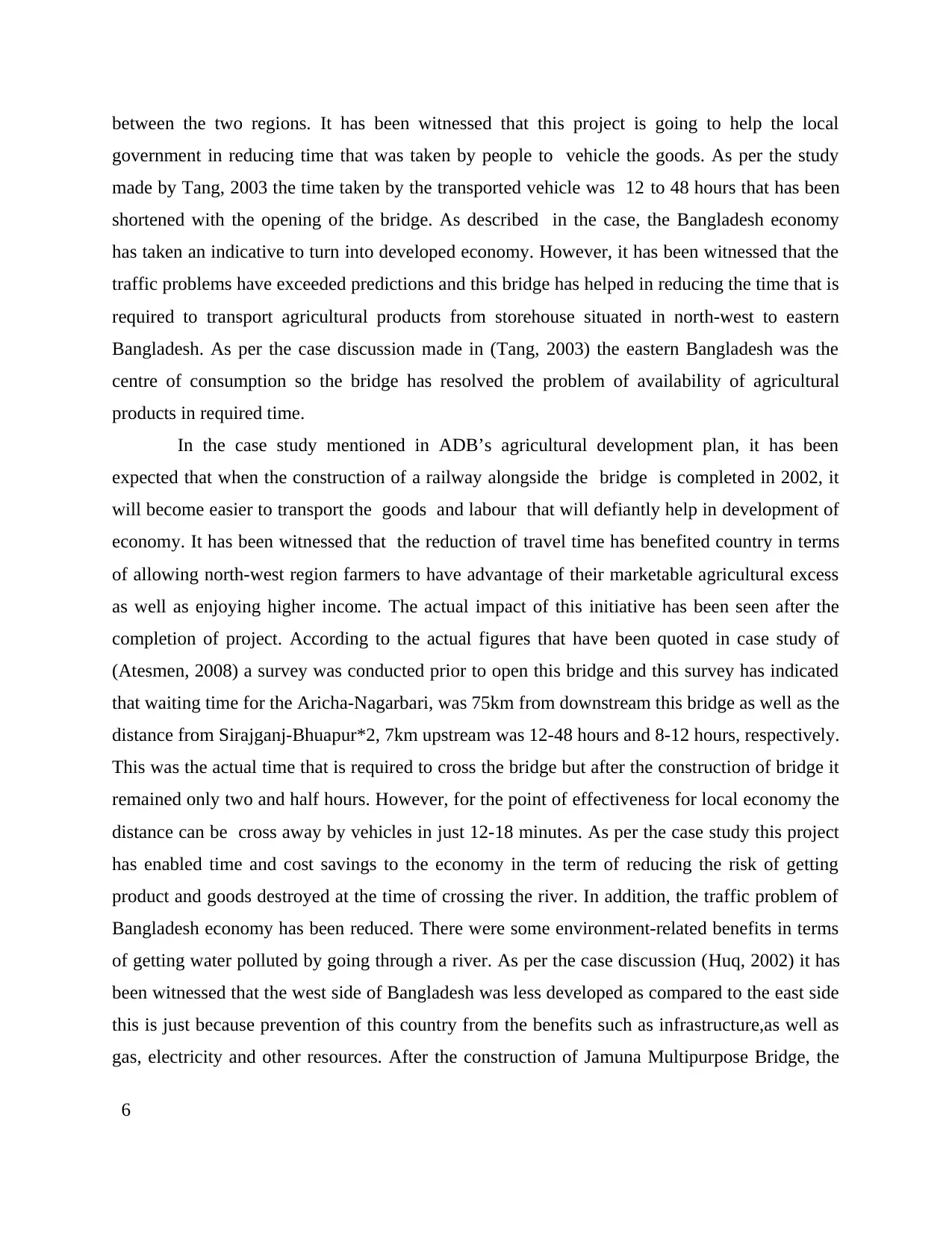
between the two regions. It has been witnessed that this project is going to help the local
government in reducing time that was taken by people to vehicle the goods. As per the study
made by Tang, 2003 the time taken by the transported vehicle was 12 to 48 hours that has been
shortened with the opening of the bridge. As described in the case, the Bangladesh economy
has taken an indicative to turn into developed economy. However, it has been witnessed that the
traffic problems have exceeded predictions and this bridge has helped in reducing the time that is
required to transport agricultural products from storehouse situated in north-west to eastern
Bangladesh. As per the case discussion made in (Tang, 2003) the eastern Bangladesh was the
centre of consumption so the bridge has resolved the problem of availability of agricultural
products in required time.
In the case study mentioned in ADB’s agricultural development plan, it has been
expected that when the construction of a railway alongside the bridge is completed in 2002, it
will become easier to transport the goods and labour that will defiantly help in development of
economy. It has been witnessed that the reduction of travel time has benefited country in terms
of allowing north-west region farmers to have advantage of their marketable agricultural excess
as well as enjoying higher income. The actual impact of this initiative has been seen after the
completion of project. According to the actual figures that have been quoted in case study of
(Atesmen, 2008) a survey was conducted prior to open this bridge and this survey has indicated
that waiting time for the Aricha-Nagarbari, was 75km from downstream this bridge as well as the
distance from Sirajganj-Bhuapur*2, 7km upstream was 12-48 hours and 8-12 hours, respectively.
This was the actual time that is required to cross the bridge but after the construction of bridge it
remained only two and half hours. However, for the point of effectiveness for local economy the
distance can be cross away by vehicles in just 12-18 minutes. As per the case study this project
has enabled time and cost savings to the economy in the term of reducing the risk of getting
product and goods destroyed at the time of crossing the river. In addition, the traffic problem of
Bangladesh economy has been reduced. There were some environment-related benefits in terms
of getting water polluted by going through a river. As per the case discussion (Huq, 2002) it has
been witnessed that the west side of Bangladesh was less developed as compared to the east side
this is just because prevention of this country from the benefits such as infrastructure,as well as
gas, electricity and other resources. After the construction of Jamuna Multipurpose Bridge, the
6
government in reducing time that was taken by people to vehicle the goods. As per the study
made by Tang, 2003 the time taken by the transported vehicle was 12 to 48 hours that has been
shortened with the opening of the bridge. As described in the case, the Bangladesh economy
has taken an indicative to turn into developed economy. However, it has been witnessed that the
traffic problems have exceeded predictions and this bridge has helped in reducing the time that is
required to transport agricultural products from storehouse situated in north-west to eastern
Bangladesh. As per the case discussion made in (Tang, 2003) the eastern Bangladesh was the
centre of consumption so the bridge has resolved the problem of availability of agricultural
products in required time.
In the case study mentioned in ADB’s agricultural development plan, it has been
expected that when the construction of a railway alongside the bridge is completed in 2002, it
will become easier to transport the goods and labour that will defiantly help in development of
economy. It has been witnessed that the reduction of travel time has benefited country in terms
of allowing north-west region farmers to have advantage of their marketable agricultural excess
as well as enjoying higher income. The actual impact of this initiative has been seen after the
completion of project. According to the actual figures that have been quoted in case study of
(Atesmen, 2008) a survey was conducted prior to open this bridge and this survey has indicated
that waiting time for the Aricha-Nagarbari, was 75km from downstream this bridge as well as the
distance from Sirajganj-Bhuapur*2, 7km upstream was 12-48 hours and 8-12 hours, respectively.
This was the actual time that is required to cross the bridge but after the construction of bridge it
remained only two and half hours. However, for the point of effectiveness for local economy the
distance can be cross away by vehicles in just 12-18 minutes. As per the case study this project
has enabled time and cost savings to the economy in the term of reducing the risk of getting
product and goods destroyed at the time of crossing the river. In addition, the traffic problem of
Bangladesh economy has been reduced. There were some environment-related benefits in terms
of getting water polluted by going through a river. As per the case discussion (Huq, 2002) it has
been witnessed that the west side of Bangladesh was less developed as compared to the east side
this is just because prevention of this country from the benefits such as infrastructure,as well as
gas, electricity and other resources. After the construction of Jamuna Multipurpose Bridge, the
6
⊘ This is a preview!⊘
Do you want full access?
Subscribe today to unlock all pages.

Trusted by 1+ million students worldwide
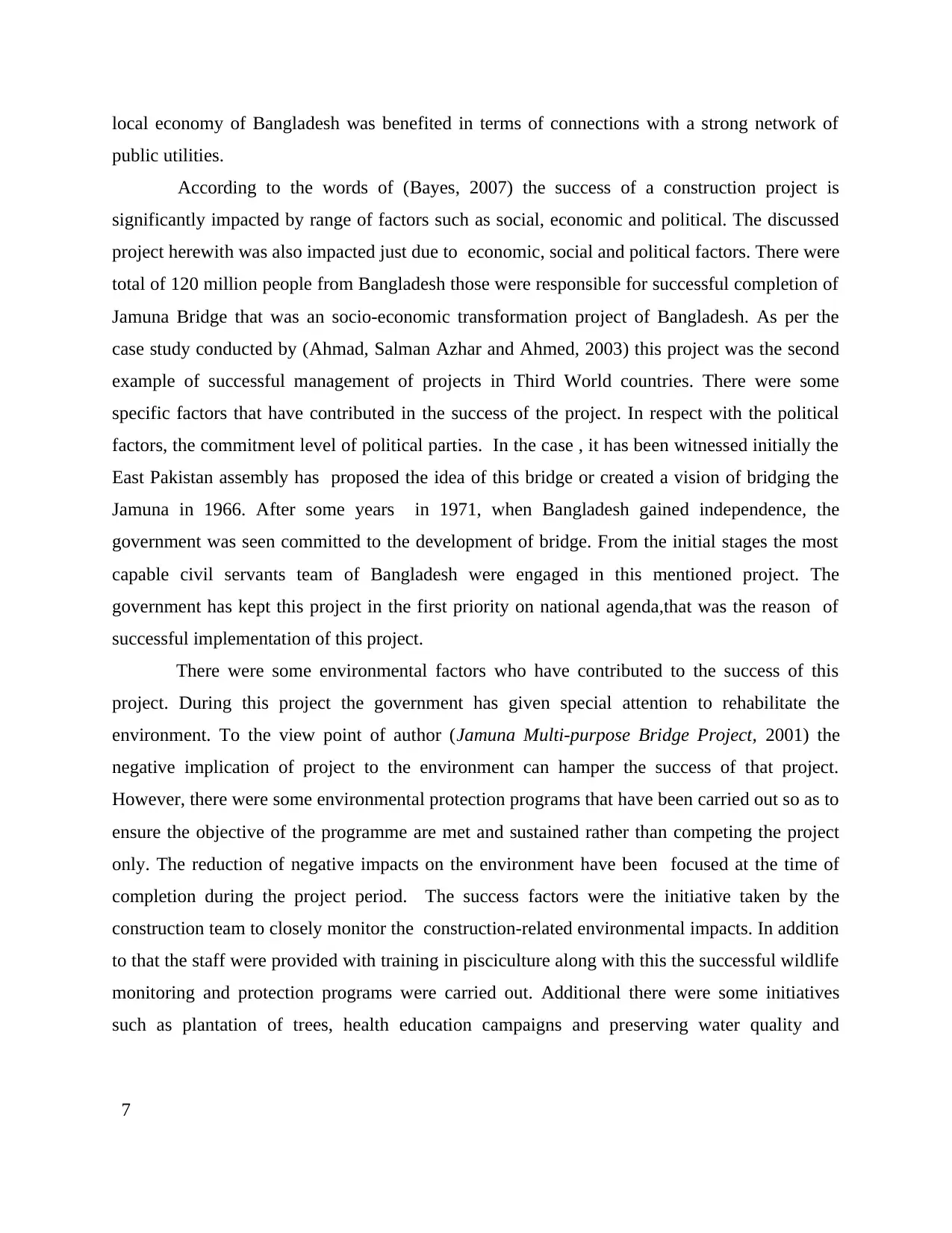
local economy of Bangladesh was benefited in terms of connections with a strong network of
public utilities.
According to the words of (Bayes, 2007) the success of a construction project is
significantly impacted by range of factors such as social, economic and political. The discussed
project herewith was also impacted just due to economic, social and political factors. There were
total of 120 million people from Bangladesh those were responsible for successful completion of
Jamuna Bridge that was an socio-economic transformation project of Bangladesh. As per the
case study conducted by (Ahmad, Salman Azhar and Ahmed, 2003) this project was the second
example of successful management of projects in Third World countries. There were some
specific factors that have contributed in the success of the project. In respect with the political
factors, the commitment level of political parties. In the case , it has been witnessed initially the
East Pakistan assembly has proposed the idea of this bridge or created a vision of bridging the
Jamuna in 1966. After some years in 1971, when Bangladesh gained independence, the
government was seen committed to the development of bridge. From the initial stages the most
capable civil servants team of Bangladesh were engaged in this mentioned project. The
government has kept this project in the first priority on national agenda,that was the reason of
successful implementation of this project.
There were some environmental factors who have contributed to the success of this
project. During this project the government has given special attention to rehabilitate the
environment. To the view point of author (Jamuna Multi-purpose Bridge Project, 2001) the
negative implication of project to the environment can hamper the success of that project.
However, there were some environmental protection programs that have been carried out so as to
ensure the objective of the programme are met and sustained rather than competing the project
only. The reduction of negative impacts on the environment have been focused at the time of
completion during the project period. The success factors were the initiative taken by the
construction team to closely monitor the construction-related environmental impacts. In addition
to that the staff were provided with training in pisciculture along with this the successful wildlife
monitoring and protection programs were carried out. Additional there were some initiatives
such as plantation of trees, health education campaigns and preserving water quality and
7
public utilities.
According to the words of (Bayes, 2007) the success of a construction project is
significantly impacted by range of factors such as social, economic and political. The discussed
project herewith was also impacted just due to economic, social and political factors. There were
total of 120 million people from Bangladesh those were responsible for successful completion of
Jamuna Bridge that was an socio-economic transformation project of Bangladesh. As per the
case study conducted by (Ahmad, Salman Azhar and Ahmed, 2003) this project was the second
example of successful management of projects in Third World countries. There were some
specific factors that have contributed in the success of the project. In respect with the political
factors, the commitment level of political parties. In the case , it has been witnessed initially the
East Pakistan assembly has proposed the idea of this bridge or created a vision of bridging the
Jamuna in 1966. After some years in 1971, when Bangladesh gained independence, the
government was seen committed to the development of bridge. From the initial stages the most
capable civil servants team of Bangladesh were engaged in this mentioned project. The
government has kept this project in the first priority on national agenda,that was the reason of
successful implementation of this project.
There were some environmental factors who have contributed to the success of this
project. During this project the government has given special attention to rehabilitate the
environment. To the view point of author (Jamuna Multi-purpose Bridge Project, 2001) the
negative implication of project to the environment can hamper the success of that project.
However, there were some environmental protection programs that have been carried out so as to
ensure the objective of the programme are met and sustained rather than competing the project
only. The reduction of negative impacts on the environment have been focused at the time of
completion during the project period. The success factors were the initiative taken by the
construction team to closely monitor the construction-related environmental impacts. In addition
to that the staff were provided with training in pisciculture along with this the successful wildlife
monitoring and protection programs were carried out. Additional there were some initiatives
such as plantation of trees, health education campaigns and preserving water quality and
7
Paraphrase This Document
Need a fresh take? Get an instant paraphrase of this document with our AI Paraphraser
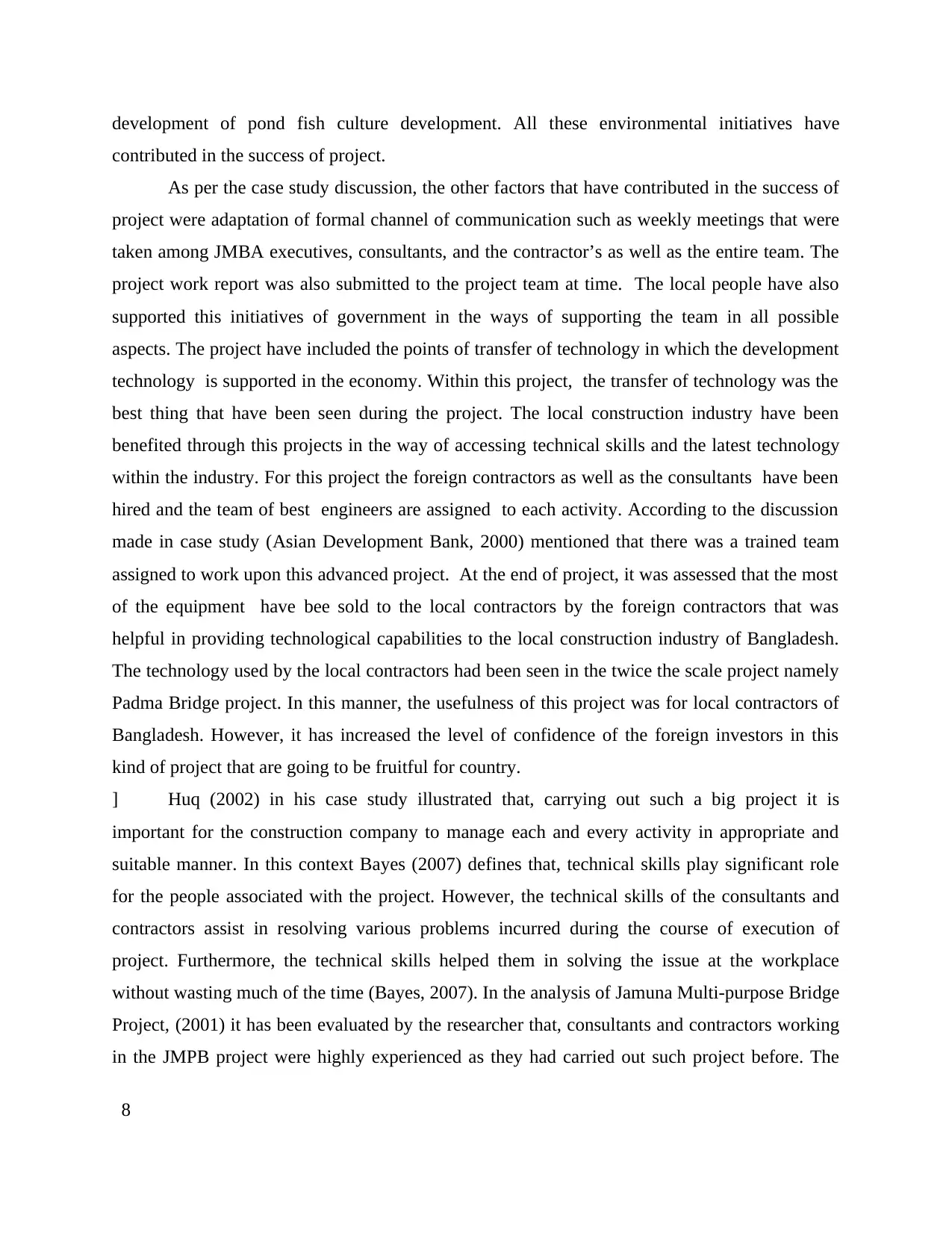
development of pond fish culture development. All these environmental initiatives have
contributed in the success of project.
As per the case study discussion, the other factors that have contributed in the success of
project were adaptation of formal channel of communication such as weekly meetings that were
taken among JMBA executives, consultants, and the contractor’s as well as the entire team. The
project work report was also submitted to the project team at time. The local people have also
supported this initiatives of government in the ways of supporting the team in all possible
aspects. The project have included the points of transfer of technology in which the development
technology is supported in the economy. Within this project, the transfer of technology was the
best thing that have been seen during the project. The local construction industry have been
benefited through this projects in the way of accessing technical skills and the latest technology
within the industry. For this project the foreign contractors as well as the consultants have been
hired and the team of best engineers are assigned to each activity. According to the discussion
made in case study (Asian Development Bank, 2000) mentioned that there was a trained team
assigned to work upon this advanced project. At the end of project, it was assessed that the most
of the equipment have bee sold to the local contractors by the foreign contractors that was
helpful in providing technological capabilities to the local construction industry of Bangladesh.
The technology used by the local contractors had been seen in the twice the scale project namely
Padma Bridge project. In this manner, the usefulness of this project was for local contractors of
Bangladesh. However, it has increased the level of confidence of the foreign investors in this
kind of project that are going to be fruitful for country.
] Huq (2002) in his case study illustrated that, carrying out such a big project it is
important for the construction company to manage each and every activity in appropriate and
suitable manner. In this context Bayes (2007) defines that, technical skills play significant role
for the people associated with the project. However, the technical skills of the consultants and
contractors assist in resolving various problems incurred during the course of execution of
project. Furthermore, the technical skills helped them in solving the issue at the workplace
without wasting much of the time (Bayes, 2007). In the analysis of Jamuna Multi-purpose Bridge
Project, (2001) it has been evaluated by the researcher that, consultants and contractors working
in the JMPB project were highly experienced as they had carried out such project before. The
8
contributed in the success of project.
As per the case study discussion, the other factors that have contributed in the success of
project were adaptation of formal channel of communication such as weekly meetings that were
taken among JMBA executives, consultants, and the contractor’s as well as the entire team. The
project work report was also submitted to the project team at time. The local people have also
supported this initiatives of government in the ways of supporting the team in all possible
aspects. The project have included the points of transfer of technology in which the development
technology is supported in the economy. Within this project, the transfer of technology was the
best thing that have been seen during the project. The local construction industry have been
benefited through this projects in the way of accessing technical skills and the latest technology
within the industry. For this project the foreign contractors as well as the consultants have been
hired and the team of best engineers are assigned to each activity. According to the discussion
made in case study (Asian Development Bank, 2000) mentioned that there was a trained team
assigned to work upon this advanced project. At the end of project, it was assessed that the most
of the equipment have bee sold to the local contractors by the foreign contractors that was
helpful in providing technological capabilities to the local construction industry of Bangladesh.
The technology used by the local contractors had been seen in the twice the scale project namely
Padma Bridge project. In this manner, the usefulness of this project was for local contractors of
Bangladesh. However, it has increased the level of confidence of the foreign investors in this
kind of project that are going to be fruitful for country.
] Huq (2002) in his case study illustrated that, carrying out such a big project it is
important for the construction company to manage each and every activity in appropriate and
suitable manner. In this context Bayes (2007) defines that, technical skills play significant role
for the people associated with the project. However, the technical skills of the consultants and
contractors assist in resolving various problems incurred during the course of execution of
project. Furthermore, the technical skills helped them in solving the issue at the workplace
without wasting much of the time (Bayes, 2007). In the analysis of Jamuna Multi-purpose Bridge
Project, (2001) it has been evaluated by the researcher that, consultants and contractors working
in the JMPB project were highly experienced as they had carried out such project before. The
8
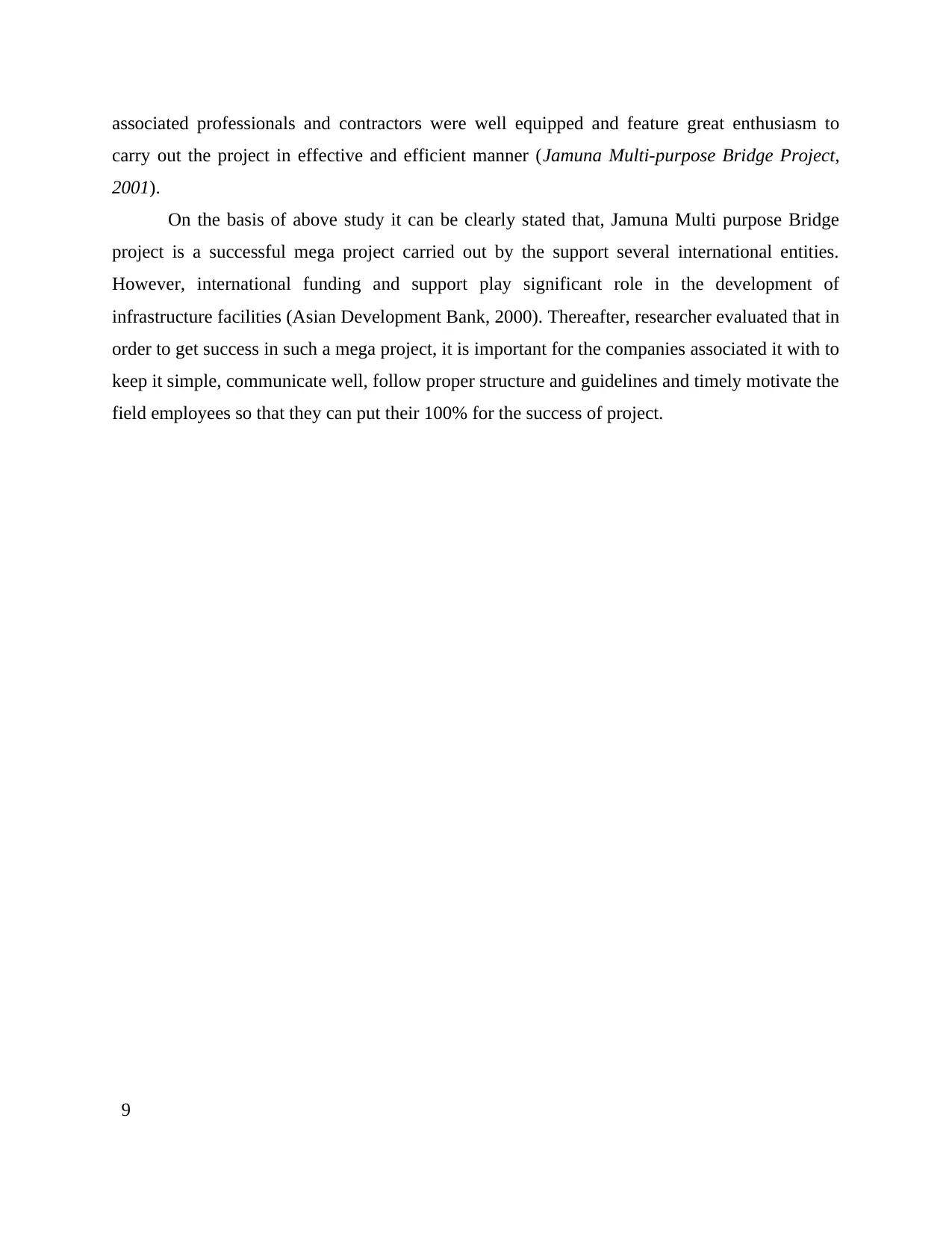
associated professionals and contractors were well equipped and feature great enthusiasm to
carry out the project in effective and efficient manner (Jamuna Multi-purpose Bridge Project,
2001).
On the basis of above study it can be clearly stated that, Jamuna Multi purpose Bridge
project is a successful mega project carried out by the support several international entities.
However, international funding and support play significant role in the development of
infrastructure facilities (Asian Development Bank, 2000). Thereafter, researcher evaluated that in
order to get success in such a mega project, it is important for the companies associated it with to
keep it simple, communicate well, follow proper structure and guidelines and timely motivate the
field employees so that they can put their 100% for the success of project.
9
carry out the project in effective and efficient manner (Jamuna Multi-purpose Bridge Project,
2001).
On the basis of above study it can be clearly stated that, Jamuna Multi purpose Bridge
project is a successful mega project carried out by the support several international entities.
However, international funding and support play significant role in the development of
infrastructure facilities (Asian Development Bank, 2000). Thereafter, researcher evaluated that in
order to get success in such a mega project, it is important for the companies associated it with to
keep it simple, communicate well, follow proper structure and guidelines and timely motivate the
field employees so that they can put their 100% for the success of project.
9
⊘ This is a preview!⊘
Do you want full access?
Subscribe today to unlock all pages.

Trusted by 1+ million students worldwide
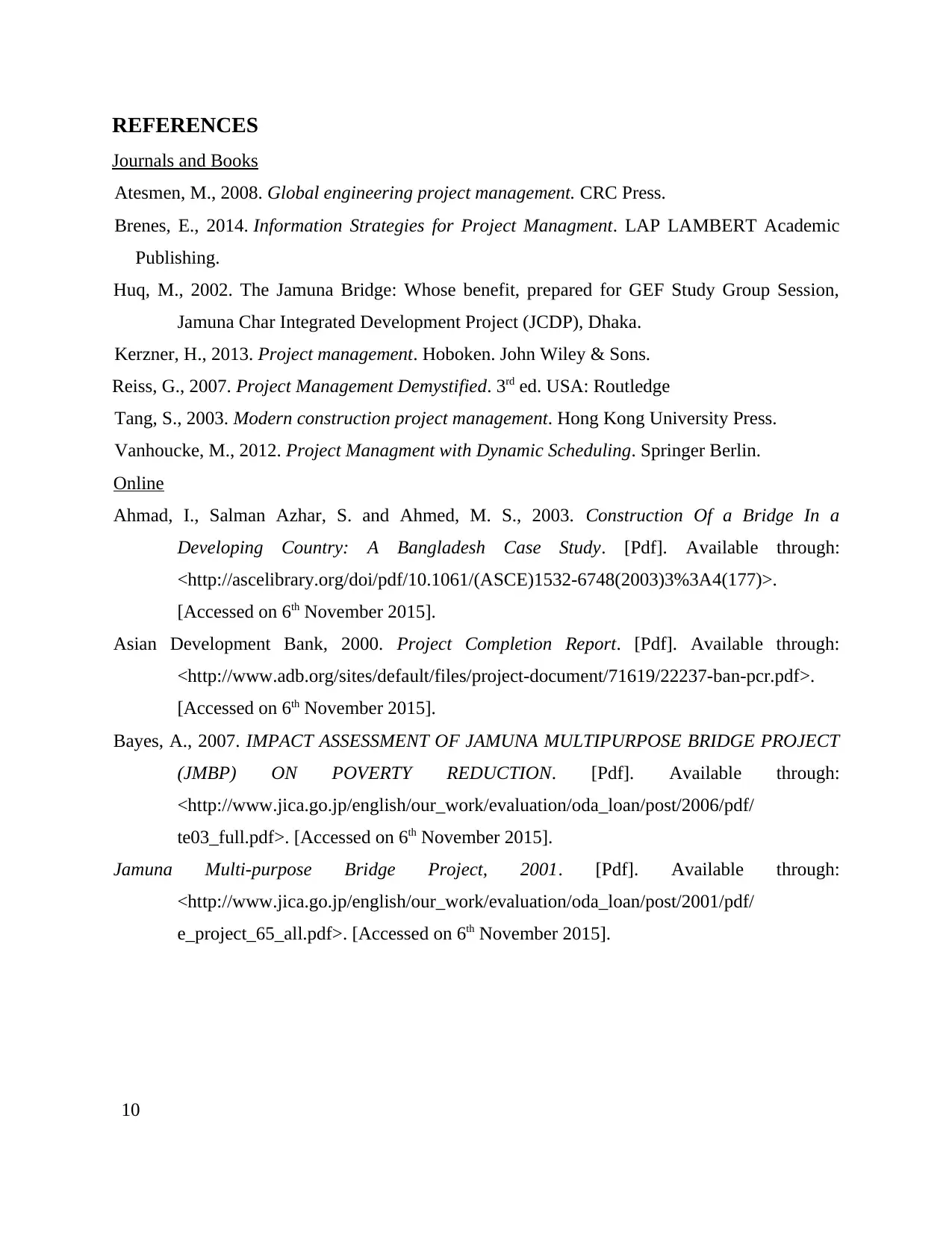
REFERENCES
Journals and Books
Atesmen, M., 2008. Global engineering project management. CRC Press.
Brenes, E., 2014. Information Strategies for Project Managment. LAP LAMBERT Academic
Publishing.
Huq, M., 2002. The Jamuna Bridge: Whose benefit, prepared for GEF Study Group Session,
Jamuna Char Integrated Development Project (JCDP), Dhaka.
Kerzner, H., 2013. Project management. Hoboken. John Wiley & Sons.
Reiss, G., 2007. Project Management Demystified. 3rd ed. USA: Routledge
Tang, S., 2003. Modern construction project management. Hong Kong University Press.
Vanhoucke, M., 2012. Project Managment with Dynamic Scheduling. Springer Berlin.
Online
Ahmad, I., Salman Azhar, S. and Ahmed, M. S., 2003. Construction Of a Bridge In a
Developing Country: A Bangladesh Case Study. [Pdf]. Available through:
<http://ascelibrary.org/doi/pdf/10.1061/(ASCE)1532-6748(2003)3%3A4(177)>.
[Accessed on 6th November 2015].
Asian Development Bank, 2000. Project Completion Report. [Pdf]. Available through:
<http://www.adb.org/sites/default/files/project-document/71619/22237-ban-pcr.pdf>.
[Accessed on 6th November 2015].
Bayes, A., 2007. IMPACT ASSESSMENT OF JAMUNA MULTIPURPOSE BRIDGE PROJECT
(JMBP) ON POVERTY REDUCTION. [Pdf]. Available through:
<http://www.jica.go.jp/english/our_work/evaluation/oda_loan/post/2006/pdf/
te03_full.pdf>. [Accessed on 6th November 2015].
Jamuna Multi-purpose Bridge Project, 2001. [Pdf]. Available through:
<http://www.jica.go.jp/english/our_work/evaluation/oda_loan/post/2001/pdf/
e_project_65_all.pdf>. [Accessed on 6th November 2015].
10
Journals and Books
Atesmen, M., 2008. Global engineering project management. CRC Press.
Brenes, E., 2014. Information Strategies for Project Managment. LAP LAMBERT Academic
Publishing.
Huq, M., 2002. The Jamuna Bridge: Whose benefit, prepared for GEF Study Group Session,
Jamuna Char Integrated Development Project (JCDP), Dhaka.
Kerzner, H., 2013. Project management. Hoboken. John Wiley & Sons.
Reiss, G., 2007. Project Management Demystified. 3rd ed. USA: Routledge
Tang, S., 2003. Modern construction project management. Hong Kong University Press.
Vanhoucke, M., 2012. Project Managment with Dynamic Scheduling. Springer Berlin.
Online
Ahmad, I., Salman Azhar, S. and Ahmed, M. S., 2003. Construction Of a Bridge In a
Developing Country: A Bangladesh Case Study. [Pdf]. Available through:
<http://ascelibrary.org/doi/pdf/10.1061/(ASCE)1532-6748(2003)3%3A4(177)>.
[Accessed on 6th November 2015].
Asian Development Bank, 2000. Project Completion Report. [Pdf]. Available through:
<http://www.adb.org/sites/default/files/project-document/71619/22237-ban-pcr.pdf>.
[Accessed on 6th November 2015].
Bayes, A., 2007. IMPACT ASSESSMENT OF JAMUNA MULTIPURPOSE BRIDGE PROJECT
(JMBP) ON POVERTY REDUCTION. [Pdf]. Available through:
<http://www.jica.go.jp/english/our_work/evaluation/oda_loan/post/2006/pdf/
te03_full.pdf>. [Accessed on 6th November 2015].
Jamuna Multi-purpose Bridge Project, 2001. [Pdf]. Available through:
<http://www.jica.go.jp/english/our_work/evaluation/oda_loan/post/2001/pdf/
e_project_65_all.pdf>. [Accessed on 6th November 2015].
10
1 out of 10
Your All-in-One AI-Powered Toolkit for Academic Success.
+13062052269
info@desklib.com
Available 24*7 on WhatsApp / Email
![[object Object]](/_next/static/media/star-bottom.7253800d.svg)
Unlock your academic potential
Copyright © 2020–2025 A2Z Services. All Rights Reserved. Developed and managed by ZUCOL.